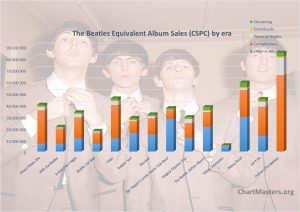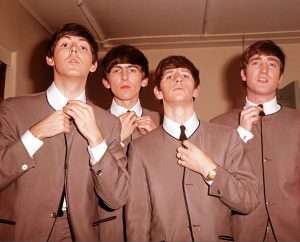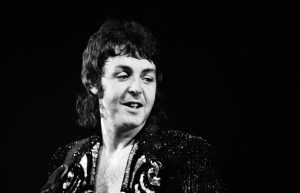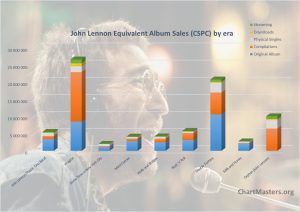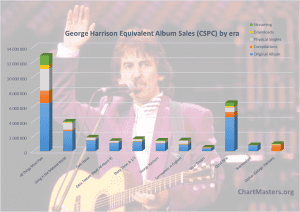Paul McCartney albums and songs sales
As part of The Beatles, Paul McCartney formed an incredible singer-songwriter partnership with John Lennon. Together, they sold hundreds of millions of records. McCartney has been highly prolific during his solo years too.
In this article, we will study in-depth his career to highlight sales figures from his 26 studio albums, plus countless compilations and singles, for a total north of 114 million equivalent album units.
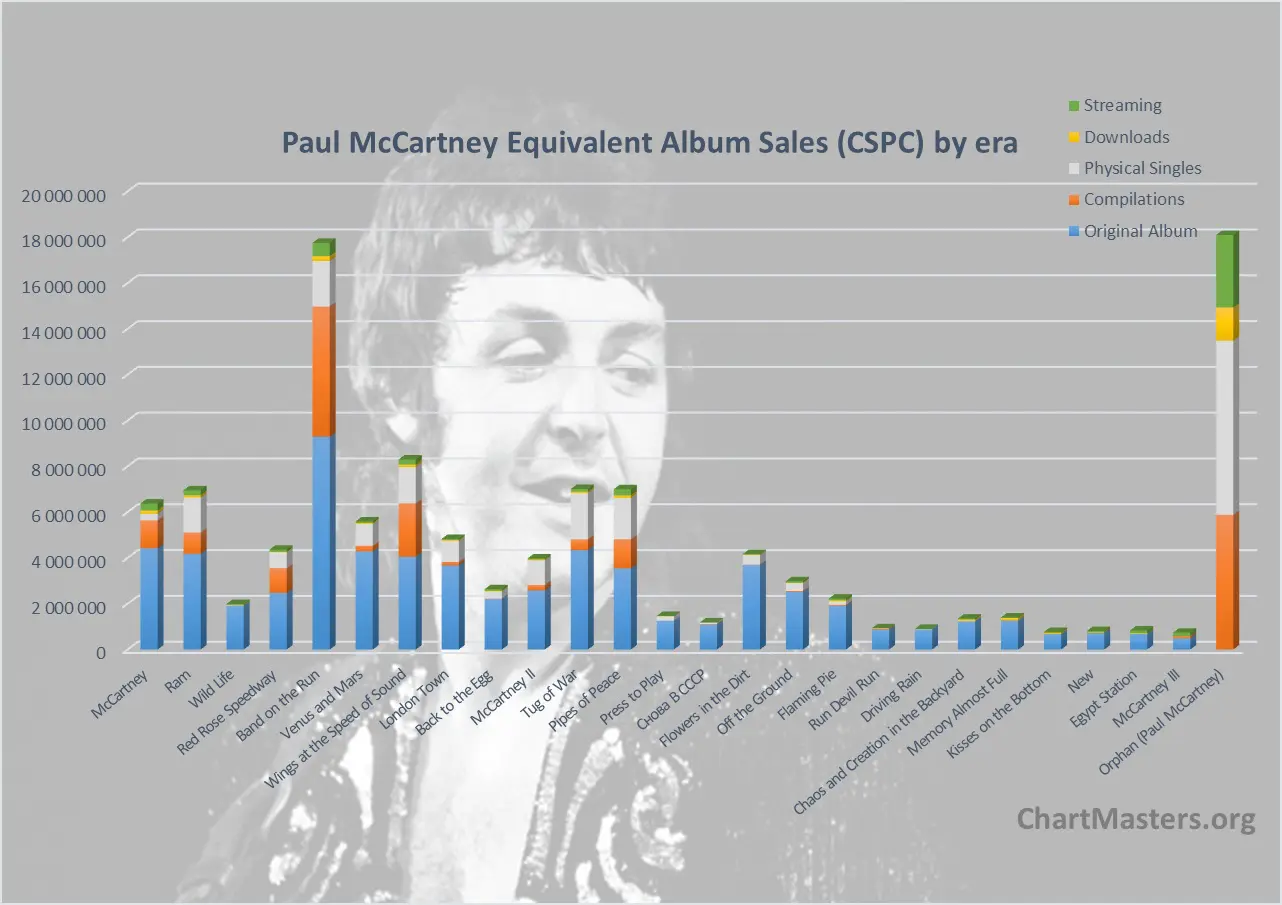
Looking at the big picture: Paul McCartney
A well structured early life (1942-1956)
Paul McCartney, born on June 18, 1942 in Liverpool, England, was the elder son of a trained nurse, Mary Patricia McCartney, and a former Jazz musician, Jim McCartney. The family had a decent enough financial situation. Despite the World War II, his environment was great to develop himself as a child.
His parents supported his interest in music, as he first learned to play the trumpet, while at school McCartney was pretty comfortable. A piano at home enabled him to engage with music even more easily. As a teenager, he started to create friendships with other boys as interested as he was in music. One of them was George Harrison, an attendee of the Liverpool institute just like him. A year younger than him, McCartney regarded Harrison as his little brother.
Once he got his first acoustic guitar, the teenager switched to this instrument as rock and roll gained popularity. Left-handed, he taught himself to play the guitar in reverse, a distinctive trait that would become a part of his signature style.
While everything looked like a highway up to that point despite the post-war hardship, the fairytale came to an abrupt end when McCartney‘s mother passed away in 1956 after a surgery for breast cancer. The young boy was only 14.
The making of the Beatles (1956-1962)
A year later, in mid-1957, he met with a local band at a party, The Quarrymen. Coming from a well structured family, McCartney was always attracted by free, rebel minds, and their band leader John Lennon was definitely one of them. Impressed by each other’s musical abilities, they quickly became friends. Their relationship only got closer when Lennon also lost his mother the following year.
As other members went in and out the band, they would welcome McCartney‘s friend Harrison from 1958. As the latter took care of the lead guitar, McCartney ended being their bass guitar player from 1961. The band was performing very often, training themselves into greater musicians.
Later that year, they performed their cult Hamburg residencies, meeting Ringo Starr in the process. The group continued to grow with the arrival of manager Brian Epstein in early 1962. Starr would join a few months later, around the same time the band signed with EMI’s Parlophone. Before the year was over, Love Me Do was released, hitting #17 in the UK.
The Lennon Beatles (1963-1965)
From the start of 1963, The Beatles got into a roll, issuing hits bigger and bigger in their homeland, most notably She Loves You and I Want to Hold Your Hand. Both songs, written by Lennon & McCartney would take fire in the US as well by early 1964.
The band had no equal in recording silly love pop songs. They did it better than anyone has ever done. During this period, his own contributions included the aforementioned Love Me Do, I Saw Her Standing There, All My Loving, Can’t Buy Me Love, or And I Love Her.
The Beatles were still, of course, Lennon‘s band. For sure, this comment is a bit provocative, just like the section title, but it’s key to understand the evolution of the group in later years to know that in the early years, each of the members saw him as the major force of the quartet, by far. It was the most evident on A Hard Day’s Night, where Lennon wrote 10 tracks out of 13, the remaining ones coming from McCartney.
Fort of his broader musical inspirations, in good part thanks to his father, McCartney became a pivotal member when The Beatles had to innovate and expand their sound. The monumental success of his song Yesterday, notably the first solo performance of the band, somewhat closed the first half of their journey. Out of their first 10 US or UK #1 hits, 9 were written or co-written by Lennon, from Yesterday, this would dramatically change.
The McCartney Beatles (1966-1970)
Starting with 1965’s Rubber Soul, the band got more and more critically acclaimed. With more diverse and complex songs, they were able to maintain the incomparable catchiness of their melodies.
Album after album, McCartney took the lead of the group, especially after the passing of Epstein in 1967. Sgt. Pepper’s Lonely Hearts Club Band was mostly his project, writing or co-writing 9 tracks to Lennon‘s 4. He then directed the movie Magical Mystery Tour, and was the mastermind of Yellow Submarine.
By the time the group recorded 1968’s The Beatles, tensions were high. Despite the 30 tracks release, no song was effectively written by Lennon and McCartney together. Instead, it almost felt like a competition, McCartney providing 12 tracks including Back in the USSR, Ob-la-di Ob-la-da, Blackbird and Helter Skelter, while Lennon signed 13, among which Dear Prudence and Revolution. Harrison (4) and Starr (1) completed the tracklist.
Maybe most importantly, McCartney was getting the big hits. From their 11th to their 27th chart toppers, he was writer or co-writer on 13. A perfectionist, seeking for control on every detail, the credit he had from these results made recording sessions even more unsustainable for the remaining members.
In fact, Lennon never really liked this situation, and after the messy weeks working on Let It Be and then Abbey Road, he decided to quit in September 1969. While they kept it secret for business purposes, McCartney used it as an opportunity to promote his debut solo album, which broke the relationship with his former friend for years. The Beatles were done, for good.
Linda & Wings years (1970-1979)
If 1969 marked the end of the Beatles, it was also McCartney‘s life start as a husband and father. In March, he married photographer Linda Eastman, and they had their first child, Mary, in August. Two more, Stella and James, would follow in subsequent years, while McCartney also legally adopted his wife’s previous child, Heather.
Well aware the success of his former band was impossible to reproduce, he was depressed by their breakup. He also decided to take a very different approach, recording his debut effort entirely on his own rather than contracting A-league collaborators. Out before the Beatles‘ final album Let It Be, self-titled LP McCartney topped US charts.
This success embarked him into another ridiculously busy decade. Not trying to replicate the Beatles‘ format, he recorded albums with whoever he wanted to for the next years. An album with his wife Linda arrived in 1971, Ram, which topped UK charts. The only other partner to stick around for some time was guitarist Denny Laine, ex-Moody Blues. Together, Paul, Linda and Denny were the core members of Wings, the name given to McCartney‘s new project.
By the end of the 70s, he had released 9 studio albums, 1 live set and 1 compilation, 6 of which topped US charts, and 3 in the UK. The only release to dominate both rankings was 1973’s Band on the Run, a phenomenal success which reminded the Beatles‘ hey-days.
Singles weren’t systematic smashes as in his previous career, but he certainly had his share of success. Uncle Albert/Admiral Halsey, My Love, Band on the Run, Listen to What the Man Said, Silly Love Songs, and With a Little Luck were all US #1s. In the UK, he got 10 top 10 hits including a trio of #2 singles until reaching the top, at last, in 1977. What a way to do it though: Mull of Kintyre moved absurd numbers, shifting over 2 million copies to break the all-time top seller there, the Beatles‘ She Loves You.
Extending the golden era to the max (1980-1985)
McCartney started the 80s almost the same way as he started the 70s, releasing a self-titled album entirely recorded by himself, McCartney II. It was a reset after Wings had vanished, with their last album 1979’s Back to the Egg selling poorly.
Lead single Coming Up topped US charts. Still, at nearly 40, McCartney knew time was working against him as far as chart success was concerned. He started to pair with other popular musicians. 1982’s Tug of War got the transatlantic #1 smash Ebony and Ivory with Stevie Wonder. For 1983’s Pipes of Piece, the pattern was no other than Michael Jackson with another huge #1 in Say, Say, Say.
Critical reception of his material was worsening though. Former Beatles fans were also rating his new albums as sub-par, and they usually had little legs. They hated 1984’s soundtrack Give My Regards to Broad Street, where he reclaimed several of his Beatles compositions by covering them. While the album sold well thanks to David Gilmour-guitar powered No More Lonely Nights, it was the end of his golden period, as he was never going to sell as well nor to get big chart hits anymore.
Later career (1986-now)
Since 1986’s Press to Play, a major commercial flop, McCartney seemingly aknowledged that his best years were over. For the next decades, he would reduce his pace of release, and more importantly record whatever he wanted to, rather than what was expected to.
The first, prime example was Снова в СССР, an album of rock ‘n’ roll covers recorded in two days and released only in USSR back in 1988. It was ultimately released globally in 1991. Two more cover albums came out later on, 1999’s Run Devil Run and 2012’s Kisses On The Bottom.
He still put out pop rock albums of originals, namely Flowers in the Dirt (1989), Off the Ground (1993), Flaming Pie (1997), Driving Rain (2001), Chaos and Creation in the Backyard (2005), Memory Almost Full (2007), New (2013), Egypt Station (2018) and McCartney III (2020).
As online downloads and pre-orders made album sales more and more frontloaded, these albums peaked higher and higher, although it isn’t really telling of their organic success. Still, Egypt Station was his first US #1 album since 1982, while McCartney III his first leader in the UK since 1989. These albums also came with their global tours, which were very successful.
As we mentioned projects of his interest, McCartney also dropped 5 classical albums from 1991’s Liverpool Oratorio to 2011’s Ocean’s Kingdom. As eclectic as ever, his releases include an additional 5 electronica albums, from 1993’s Strawberries Oceans Ships Forest to 2008’s Electric Arguments.
All in all, we are looking at a discography with over 100 singles, and nearly as many albums once we consider every type, studio sets, compilations, and live albums, up to 2024’s One Hand Clapping. While it’s clear that he lived his best years from the start of the 70s to mid-80s, we will entirely break down his sales figures era by era in this article.
ChartMasters’ method: the CSPC
As usual, I’ll be using the Commensurate Sales to Popularity Concept (CSPC) in order to relevantly gauge the act’s results. It will not only bring you sales information for all albums, physical and download singles, as well as audio and video streaming. In fact, it will really determine the act’s popularity.
If you are not yet familiar with the CSPC method, below is a nice and short video of explaining the concept. I recommend watching it before reading on and to the sales figures. You’ll get the idea in just two minutes.
And if you want to know the full method as well as formulas, you can read the full introduction article.
Now let’s get into the artist’s detailed sales figures!
Paul McCartney album sales

Updated studio album sales & comments
Both McCartney and Ram were great sellers upon release. At over 4 million a piece, they may disappoint in comparison to the Beatles‘ top sellers. It doesn’t make that much sense to put these albums head to head though. The latters had albums barely cannibalized by compilations, with many hits released as stand-alone singles which filled their greatest hits packages without negatively impacting catalog sales of their studio efforts.
McCartney on his side had a more traditional career. His big hits are part of his albums, so as soon as he got live sets and compilations released, his original albums slowed down a lot. In this context and keeping in mind the market size in early 70s, 4 million units is a great, great number.
What wasn’t so great was Wild Life which struggled to do well, even though it came close to 2 million sales ultimately. This step back could have threatened the selling power of the singer but Band On The Run quickly made him as hot as ever. The LP maintained a ranking inside the very best positions for various months, selling past 9 million copies to date. By 1976 it wasn’t that much behind the Beatles‘ own biggest albums.
After this blockbuster, his popularity started to go down but at a very slow pace. The album format was also booming during the second part of the 70s, so all his new albums up to 1984 managed to maintain sales in multi-millions worldwide, although none reached 5 million.
From Press to Play, his years as a star seller were mostly over, especially in the US. Flowers in the Dirt and Off The Ground did wonders in some European markets, pushing them to 3.7 million and 2.5 million worldwide, respectively.
Overall yet the last 35 years have been lacking cross over hits for McCartney even if his fanbase continues to be very loyal after all these years. In fact, McCartney III, his lowest selling era, sold nearly half a million units which is great by 2020 standards. He is up to 64.2 million units sold combining his 26 solo albums.
Want to compare the act’s albums with others?
Paul McCartney songs sales
Below, we list down results from the artist through physical sales, digital sales and streaming.
Please be aware that when the artist is regarded as the lead act, they are rewarded with 100% of these units. However, featured acts share a 50% piece of the total.
Physical singles
After selling millions of virtually every single issued as part of the Beatles, one could expect McCartney to continue on this golden road as a solo act. He did.
His first proper solo single was actually Another Day, a non-album single recorded during Ram sessions and later added to this album. It sold over 2.6 million units with great sales in every continent. Follow up Uncle Albert easily eclipsed the million plateau too at almost 1.9 million. It was the singer’s first US #1 solo hit.
The debut album didn’t receive physical singles at first. About 6 years later, a live version of Maybe I’m Amazed came out to promote Wings Over America, shifting nearly a million.
Before that, singles out of 1973-1975 albums smashed too. My Love was #1 for 4 weeks in the US while Band On the Run and Listen To What The Man Said made the top too. They combine for over 7 million sales, all of them being comfortable million sellers. Helen Wheels and Jet were solid Top 10 hits in most major markets, also selling well at 1.3 million and 2 million, respectively.
While no song really went through the roof, hits kept coming. Silly Love Songs (US 5 weeks #1, 2.7 million), Let ‘Em In (1.7 million) and With A Little Luck (2.3 million) made it look easy for McCartney and his Wings.
In-between, the prolific songwriter dropped multiple stand-alone hits too. Hi Hi Hi and Junior’s Farm sold 1.5 million apiece, while James Bond theme Live And Let Die shifted 2.7 million. Then came Mull Of Kintyre in 1977.
If McCartney needed 7 years before reaching the top post-Beatles in his homeland, he did so in great fashion with this stunning 9-weeks #1 single that moved a record breaking 2 million units in the UK alone. Globally, the song sold in excess of 6 million.
1979’s era Back To The Egg was the first to really flop with no single reaching even the Top 10 in both the US and the UK. Ironicaly, while this marked the end of the continuous string of successful songs for the artist, it’s also when bigger and bigger hits started to emerge.
Coming Up was 3 weeks #1 in the US, en route to 2.9 million sales worldwide. After a full 2 years of absence, Stevie Wonder‘s duet Ebony And Ivory led the Hot 100 for an impressive 7 weeks while also topping UK charts. It sold 5.4 million units.
Then, the Michael Jackson-aided duet Say Say Say went on to do almost as well at 5 million sales. A 6-weeks #1 hit in the US, this remains the very last of an all-time record of 32 American chart toppers for McCartney. It’s also his highest selling single in various markets like France.
This contribution of Jackson to help supporting the LP Pipes Of Peace was a lift return after McCartney helped to pave the way to the historical campaign of Thriller that started with the 2-million selling duet The Girl Is Mine.
No More Lonely Nights with its 1.65 million sales extended even deeper this impressive run. It was the last million seller of the artist, while follow up Spies Like Us from 1985 became his last Top 10 hit. Well, last Top 10 as a leading artist since 2015’s FourFiveSeconds went to #4.
Physical singles from 1986 onwards have been weaker and weaker, which seems fairly natural for a singer up to 44 by that time. Additional releases up to now bring his total to a massive 73 million physical singles on top of the 127 million he sold with the Beatles, a lovely 200 million total.
Digital songs
While the solo career of McCartney was full of Top 10 and #1 hits in many places, his back catalog is nowhere near as loved nowadays.
From his debut album, Maybe I’m Amazed remains one of his hottest tunes. It has recorded a good although not incredible 735,000 digital sales so far, made of downloads and ringtones.
As many as 8 songs from Ram came out as A/B sides of singles back in the day, many of which went to the top in some markets. Right now, they are all mostly forgotten as none reaches even 250,000 digital sales, not even Another Day or Uncle Albert.
The same can be said about the former #1 smash My Love which can only claim residual sales right now. We need to go up to the album Band On The Run and its title track to face another song that is still getting real love. With 635,000 sales to date, it is one of his most popular songs out of all his studio efforts. Jet also retain some fame with 235,000 sales in digital formats.
Everything that came out from 1975 to 1980 have been struggling too. A chart topper like Listen to What the Man Said register dreadful numbers below 6 digits. Mull Of Kintyre, Silly Love Songs, and With A Little Luck record about 300,000 sales on average.
Shockingly, Ebony And Ivory can’t make it to past 235,000. A huge smash in 1982, the song sounds very dated for the general public. Say Say Say is arguably bigger, especially since it was boosted by the passing of Jackson. This is also true with The Girl Is Mine, both among the rare songs from his back catalog to break the half a million mark.
The last one is the holiday title Wonderful Christmastime. Hardly his most praised song, the recurrent airplay it receives every year fueled it to nearly 1 million downloads and ringtones.
These fairly low results are strongly boosted by a trio of 2015 hits with modern artists. Along with Kanye West and Rihanna, the legendary author issued several featurings that year. They all contributed to FourFiveSeconds, a 4.2 million selling hit. Then West / McCartney songs Only One and All Day sold roughly 700,000 units each. These 3 songs add for 30% of the artist’s total of 18 million sales to date in digital singles.
Streaming
Streaming is made up of both audio and video streams. Our CSPC methodology includes both formats to better reflect the real popularity of each track.
The main source of data for each avenue is Spotify and YouTube, respectively. To factor in the growing impact of multiple Asian countries where these platforms aren’t always the go-to site for music streaming, more sources have been added.
In order to account for their real popularity in each relevant country, the below sources have been used along with the mentioned ratios that reflect the market share of each area.
Audio Streams
– South Korea: Genie streams * 2.20 (consistent with Gaon streaming numbers)
– Japan: AWA streams * 100 / 4 (AWA has 4% of the Japanese streaming market)
– Arabic world: Anghami streams
– Sub-Saharan Africa: Boomplay + Audiomack streams
– Elsewhere: Spotify streams * Spotify market shares based on artists’ market distribution
Video Streams
– China* : QQ video streams * 50 if the song is available for audio stream, QQ video streams * 5 elseway (scale built based on known figures for several major artists)
– Elsewhere : Youtube views increased by 10% to account for various local platforms
*since Chinese streaming platforms are mostly video streaming platforms, their streams are weighted on par with YouTube streams.
Audio Stream value – 1,500 plays equal 1 album unit
Video Stream value – 6,750 views equal 1 album unit
Equivalent Albums Sales (EAS) = ( Spotify * ArtistRatio + Genie * 2.20 + AWA * 100 / 4 + Anghami + Boomplay + Audiomack ) / 1500 + ( QQ views* 50(or 5) + YouTube * 1.1 ) / 6750
Top hits
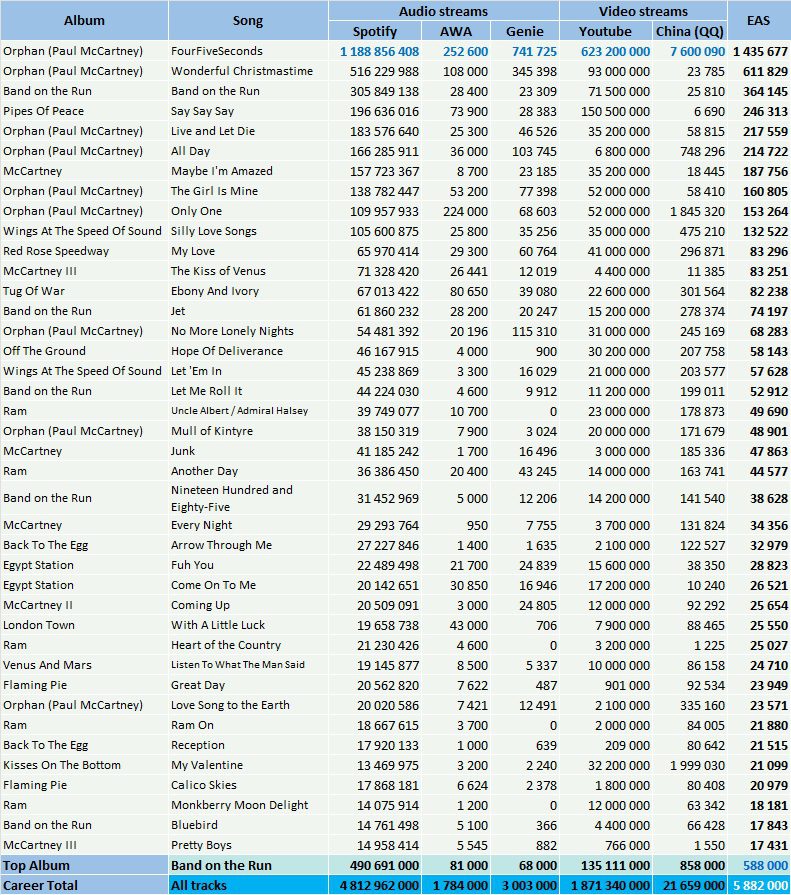
The biggest hit from Paul McCartney on streaming platforms is FourFiveSeconds. The 2015 hit is obviously at an advantage compared to legacy recordings. It has 1.2 billion streams on Spotify, and over 600 million views on YouTube. Both duets with Kanye West All Day and Only One also rank inside the top 10.
With the legendary songwriter lacking a real big catalog hit, Wonderful Christmastime benefits from the boom of holiday songs on streaming providers to be lead the way among legacy tunes with over 600,000 equivalent album sales.
With Spotify streams ranging from 100 million to 300 million are Band on the Run, Say Say Say, Live and Let Die, Maybe I’m Amazed, The Girl Is Mine, and Silly Love Songs.
Nothing else hits 9 digits, although it’s worth noting that McCartney‘s discography is large, especially if we add The Beatles‘ one on top of that. In fact, no less than 37 additional songs are over 10 million. Some of them are recent releases as well. Egypt Station performs especially well among post-80s albums, with two songs topping 20 million, Fuh You and Come On To Me.
As many of his biggest streaming hits are stand alone tracks (6 out of the top 9), Band on the Run still surfaces on top among album, with over half a million sales from streams.
Full catalog breakdown
If you are familiar with the artist’s catalog and want to check details of each and every song, you can access to all of them right here.
Keep yourself up to date
Our website provides you a fantastic tool which fetches updated Spotify streams as you request them, use it to watch these results grow day after day!
Paul McCartney compilations sales
It sounds fairly logical to add together weighted sales of one era – studio album, physical singles, downloads, streams – to get the full picture of an album’s popularity.
However, older releases generate sales over various live, music videos and compilation albums. And all those packaging-only records do not create value. They exploit the value originating from the parent studio album with each of its tracks instead. Inevitably, when such compilations are issued, they downgrade catalog sales of the original LP.
Thus, to accurately gauge the worth of these releases, we need to re-assign sales proportionally to its contribution of all the compilations which feature its songs. Here is how we do that.
Assigning compilation sales to original studio albums

How do you understand this table? For example, if we check the All The Best ! line, these figures mean it sold 7,015,000 units worldwide. The second statistics column means all versions of all the songs included in this package add for 1,241,757 equivalent album sales from streams across all formats.
The second part (on the right of the table) shows how many equivalent streams are coming from each original album, plus the share it represents in the overall package.
Therefore, the streaming figures convey that songs from Band on the Run equate to 35% of All The Best !‘s tracklist attractiveness. Meaning, it generated 2,463,000 of its 7,015,000 album sales and so on for the other records.
Raw compilations sales
In years with no studio release, McCartney was busy issuing compilations and live sets for most of his career. The first big one was the 3.6 million seller Wings Over America in 1976, followed by Wings Greatest with 3.7 million sales in 1978.
The 80s saw two more relevant packages, Give My Regards to Broad Street at 2.6 million and All The Best ! at 7 million. The latter one came just in time to enjoy the CD replacement era.
Early 90s were prolific in live releases. Tripping The Live Fantastic sold 2.3 million as a double album and 800,000 as a 1-CD highlights disc, Unplugged 800,000 too, and Paul Is Live moved close to a million, plus over 400,000 from video formats.
The flurry of strong selling live albums continued in the 00s with Back in the U.S. / World at 2.7 million combining both CDs and the DVD, while Good Evening New York City sold 900,000. As for compilations, Wingspan did 2.1 million.
An artist that constantly sells as many live albums (15.3 million in total) as compilations (16.6 million) feels completely bogus. Usually, they tend to do only 10% to 20% of compilations released around the same time with similar tracklists.
The key point here is that these packages do not have the same tracklists. While compilations focus on McCartney solo years, either really solo or with Wings, live albums contains The Beatles‘ songs he composed and kept performing. That is why their strength is so much bigger relatively speaking. It also means that a good chunk of McCartney‘s live and video releases are inherited from The Beatles‘ songs, and are consequently distributed to them instead.
Another highlight are classical and electronic albums. The 10 of them combine for 1.2 million sales.
Re-assigned compilation sales – Results & comments
Here is the most underestimated indicator of an album’s success: the amount of compilation sales across all versions that were generated. Due to the dependency of sales of the original studio albums on these releases, they are a key piece of the jigsaw.
To clarify that, we take the Raw compilation sales results and assign the numbers to the related original studio albums, as described in the first section Assigning compilation sales to original studio albums.

Band on the Run is the obvious leader in the list. It generated nearly 5.7 million sales of compilations or live albums. Maybe surprisingly, numbers drop sharply for everything else. Wings at the Speed of Sound tops 2 million, but then only four more albums fueled around a million sales, McCartney, Ram, Red Rose Speedway, and Pipes of Peace.
This is in part due to many of his hits coming from stand-alone tracks, which combine for nearly 6 million sales under the Orphan umbrella. It’s also due to the aforementioned situation where McCartney sold a lot of live albums and videos thanks to his songs from The Beatles‘ days.
In fact, as many as 13.6 million out of his 33.6 million sales of compilations have been fueled by the band’s recordings. As per our CSPC methogolody, these sales are allocated to the parent albums of these songs inside The Beatles‘ totals. It’s very clear on this table: while compilations and live albums from McCartney sold roughly the same, a mere 16% of his live albums sales come from him, which explains the much lower values in the related column.
We can also point out how some of his albums are completely dead, with songs barely ever used anywhere else than on the original album. Among these are records like Wild Life, Back to the Egg or Press to Play. A bigger surprise may be Venus and Mars. A hit album back then, we can see it was mostly thanks to hype as its impact on McCartney‘s catalog in the long run has been tiny.
Bonus: Top selling compilations’ breakdowns

Bonus: Total album (all types) sales per country

Please note country-specific numbers may miss sales of a few minor releases, although totals are complete.
Paul McCartney: career results (CSPC)
So, after checking all the figures, how many overall equivalent album sales has each album achieved? Well, at this point we hardly need to add up all of the figures defined in this article!

Albums results (CSPC)
In the following results table, all categories display figures in equivalent album sales. If different, pure sales are listed between parentheses.
As a reminder:
- Studio Album: sales of the original album
- Other Releases: sales of compilations generated thanks to the album
- Physical Singles: sales of physical singles from the album (ratio 3/10)
- Download Singles: sales of digital singles from the album (ratio 1,5/10)
- Streaming: equivalent album sales of all the album tracks (ratio 1/1500 for Audio stream and 1/6750 for Video stream)
Artist career totals
See where the artist ranks among remaining singers
Once sales in every format is combined, Band on the Run is the clear front runner with close to 18 million equivalent album sales. It has enough traction on streaming to climb decently in the future.
It could be surprising, but there’s nothing else in sight until we go down to 8.3 million sales to meet with Wings at the Speed of Sound. Next up are a trio of albums in a virtual tie at 7 million, Tug of War, Pipes of Peace, and Ram. Debut album McCartney at 6.4 million, and Venus and Mars at 5.6 million illustrate how stacked his catalog is. When you release a new album album almost every year for over 20 years, maintaining these numbers is already amazing.
More albums stand on similar scores, led by London Town at 4.8 million. Not too far behind are Red Rose Speedway (4.4 million), Flowers in the Dirt (4.2 million), and McCartney II (4 million).
Except Wild Life and Back to the Egg, which are still 2 million plus sellers, every album from the first 12 released sold at least 4 million. While only one album has really big sales, the overall picture is no doubt impressive.
Moreover, it continues even deeper into his career. Up to 1997’s Flaming Pie included, all his albums topped a million, and 2 million plus was still the norm. Numbers did drop below a million for the first time with 1999’s Run Devil Run. Incredibly, he maintained this level ever since, averaging 970,000 units for his 7 albums released this millennium. His last album, McCartney III, is the lowest seller, but sales remain healthy at 740,000 units so far.
Furthermore, the orphan umbrella is crowded with hits and side projects totalling a whopping 18.2 million sales.
Over the course of his solo career, Paul McCartney has shifted 115 million equivalent album sales. This doesn’t account for the 13.6 million units sold under his name thanks to The Beatles material. An unbelievable score for a career that isn’t his main one.
Singles results (CSPC)
The list is compiled in album equivalent sales generated by each song. Therefore, these figures are not merged units of singles formats. Instead, the list includes weighted sales of the song’s physical single, download, ringtone and streaming as well as its share among sales of all albums on which it is featured.
Want to compare the act’s songs with other top hits?
Discography results (ASR)
Thanks to our new ASR (Artist Success Rating) concept, we know that sales represent 3.71 million times the purchase of entire discography. Coupled with total sales, it translates into an ASR score of 84. The ranking of all artists studied so far is available too at this link.Records & achievements
- Paul McCartney is the most successful music artist of all-time, the only one to break 500 million EAS combined.
- As a songwriter, Paul McCartney amassed a record-breaking 32 US #1 singles.
- Paul McCartney is the only artist ever who topped the US Hot 100 as a solo act, as part of a duo, of a trio, of a quartet, and of a quintet.
- As a musician, Paul McCartney amassed a record-breaking 27 US #1 albums.
- Along with Phil Collins, Paul McCartney is one of the only 2 persons to break 100 million EAS twice as part of a group and then again with subsequent efforts.
- At 17,798,000 EAS, Band On The Run is the 5th most successful album from 1973.
- Mull Of Kintyre was back the best selling single ever in the UK, the first to sell 2 million units.
Dynamic Spotify key performance indicators
Paul McCartney

Current followers count: 5,194,592 5,000,000 followers have been reached on 12/25/24 4,000,000 followers have been reached on 05/26/22 3,000,000 followers have been reached on 06/24/20 >> Daily breakdown
Paul McCartney is #773 among the most followed artists of all-time >> Visit our Top 5,000 most followed artists ranking
Current streams count: 3,194,251,839 3,000,000,000 streams have been reached on 01/27/25 2,000,000,000 streams have been reached on 01/20/25 3,000,000,000 streams have been reached on 01/19/25 2,000,000,000 streams have been reached on 08/19/24 3,000,000,000 streams have been reached on 02/22/23 2,000,000,000 streams have been reached on 02/18/23 3,000,000,000 streams have been reached on 02/13/23 2,000,000,000 streams have been reached on 02/12/23 3,000,000,000 streams have been reached on 01/21/23 2,000,000,000 streams have been reached on 02/23/21 >> Daily breakdown
Paul McCartney is #893 among the most streamed artists of all-time Popularity Rating: /100 >> Visit our Top 1,000 most streamed artists ranking >> Visit our Top 20 highest rated artists ranking
Current monthly listeners: 11,980,760 (Trend: 331,744) Global chart position: N/A The artist top 50 cities come from 22 distinct countries >> Global impact breakdown
As usual, feel free to comment and / or ask a question!
Sources: IFPI, Spotify, YouTube, Discogs.
You may be interested in…
… Paul McCartney‘s streaming masters analysis
… checking out the upcoming artists or even voting for them!
… similar artists
… best-selling artists, albums, and singles
Artists
360° analytics – Best-Selling Artists | by Decade
Tools: Artist Dashboard | Artists Comparator
Streaming deep dive – Most-Streamed Artists
Tools: Playcounts | Royalties | Global Reach | Stats History
Other KPIs – Monthly listeners | Followers | Top money makers
This article is being discussed in our forum, join us to share your comments! »

























